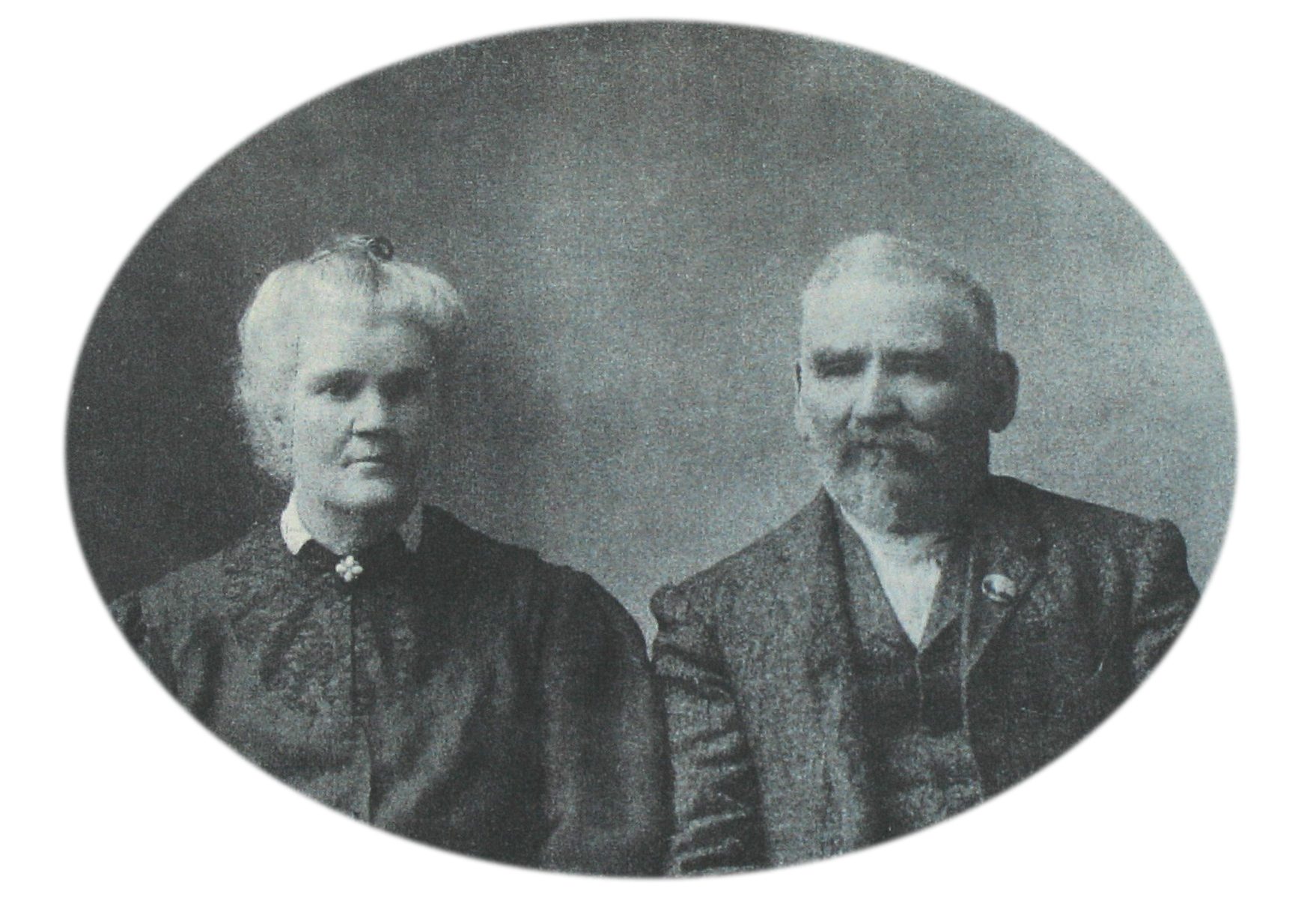(Pictured: Alice Ann Tolman and Lorentz Dastrup)
(Contributed by the Thomas Tolman Family Organization. Excerpt from Judson Tolman: Pioneer, Lumberman, Patriarch by E. Dennis Tolman, Second Edition, 2004, pages 100-101).
Alice Ann Tolman was born June 3, 1852 in Tooele, Utah as the third child and oldest daughter of Cyrus and Alice Tolman. Alice Ann grew up with many
brothers and sisters. She had measles and scarlet fever at twelve years of age.
December 19, 1868 Alice was married and sealed in the Endowment House in Salt Lake City, Utah to Hans Lorentz Dastrup, Jr. Lorentz arrived in New York from Denmark, February 16, 1856. He said, “We were eleven weeks and three days on board ship…Then we were three weeks riding in cattle cars while coming from New York to St. Louis.” Then he moved to Omaha in May 1857 and left for the west on July 3, 1859. Lorentz recorded, “While crossing the plains to Utah, I walked all the way, except for one half day, when I was ill.”
(Several times he mentioned that he wished he did not have that half day’s ride, so he could say that he had walked all the way across the plains.) He arrived in Salt Lake City September 15, 1859. The first work which he did was making baskets. He moved to Cottonwood in 1861, then moved to Mt. Pleasant in 1862, then another move to Richfield, Sevier County in 1865. Lorentz helped to make the first canal in Sevier County. He fought the Indians and could relate some of the trying experiences he had while doing so.
Alice and Lorentz made their first home in Scipio, Utah in 1869. When they married, Lorentz described Alice as slender, beautiful and a good dancer. She never missed a dance and was so popular. Alice was five foot four inches tall with brown eyes and black hair. Lorentz played for the dances. When Richfield was resettled in 1871, they moved there. In 1873 they moved to Gunnison, then on to Salina, July 24, 1883, where they remained until their deaths.
Alice and Lorentz were blessed with twelve children: Emmeline Dastrup Mortensen, Alice Dastrup, Annie Maria Dastrup, Sarah Jane Dastrup, John Alvin Dastrup, Lorentz Albert Dastrup, William Dastrup, Denwall Dastrup, Josephine Dastrup O’Kesson; George Alexander Dastrup, Alvaretta Dastrup, and Magdelene Dastrup.
Alice Ann developed dropsy and was a semi-invalid for quite a time. The doctor in Salina had to draw water from her legs. Her family knew how ill she was, so the children, Emmeline, Sarah, Ann, John and Albert had to hire out for wages. They got what schooling they could between times. They did house work and took in washing for the better-to-do folks, and did sewing. Sarah was a dressmaker and did lovely work. The boys did chores, milked cows, raised their meat and vegetables, and hauled wood to keep the big fireplace going and the kitchen stove burning. The fire never was out in the winter time. They also hauled wood for others to get money for clothing. Lorentz hunted for wild game such as lots of geese, ducks, chicken and venison. Alice Ann picked the feathers for feather-bed and had straw ticks for beds.
The house was made of logs and a well plastered shingle roof. There were three rooms on the ground floor and bed rooms upstairs. Lorentz with the help of their boys bought adobe bricks and built three rooms on the back of the log house, making it “T” shaped. They bought the “Knighton Hotel” and changed the name to the “Dastrup Hotel.” They sold the farms across the Sevier River, one of them to their son, John Alvin, for $800.00 to help pay for the Hotel. Alice had regained her health, and was the cook and manager. She became known by all the drummers, who sent many travelers to their hotel. Alice Ann hired her help, but Emmeline was her main help. Then Josephine, and Albert, and John’s fiance, Marie Hermansen, came and worked for her until Marie and John got married. Florence Curtis also worked for Alice Ann until she and Denwall got married.
Lorentz loved to fish, but would never clean them. He would bring them to Alice to clean, cook and salt away. She told him one day, “Lorentz, if you don’t clean those fish just as sure as you live I’ll cook them with guts in.” Lorentz laughed and said, “Ah, You wouldn’t do that.” Well, the next time Alice sure did, and Lorentz was horrified, got mad, and then laughed, and said, “Well, you kept your word.” The fish were cleaned after that.
Lorentz did gun repair work in a shop which they built on part of the lot where the Hotel stood. The boys had bunk beds in one end of Lorentz’s gun-shop which was connected to the main house. They also built a large “Sample Room” on Main Street, where drummers could show their goods. Later this was sold for a rental home. Because of poor health and Lorentz’ unhappiness at not having a private home, they sold the Hotel and bought a rock house from Hyrum Gates. The house still stands, two blocks south of Main. Lorentz died there.
Alice seemed to be blessed with “warning intuitions.” She also studied people and could read character. She read “life lines” from their hands and face. Many people said they were helped by her. Lorentz said she often would say to him, “Lorentz, I don’t think you should go there or do this or that.” And if he went anyway he said, he would find out that she was right. So he would consult her on his problems. Alice was a devoted Relief Society member and always went to her meetings as much as possible. Lorentz read church books a great deal and was very well versed.
Lorentz died October 13, 1916, on his father’s birthday, in Salina where he was buried. Alice sold the big house and bought a four room home across the street where she was very happy and comfortable. She stepped on her freshly waxed floor, fell and broke her hip. Peritonitis set in, causing her death. It was recorded, “January 19, 1922, Alice Ann Tolman, widow of Lorentz Dastrup passed to her reward after an illness of four days, as the result of a fall. It was rather a gloomy ushering in of the New Year for the family. She was full of merriment and a humerous mimic, and for many years the younger members of the family were regaled with the recital of the many funny yarns told by Aunt Alice.” She was buried beside Lorentz. (The Dastrup Family, p. 23.)


